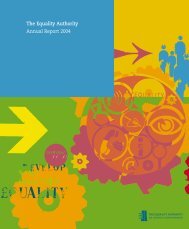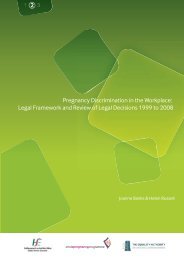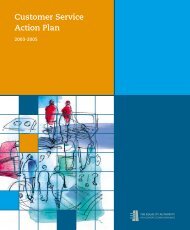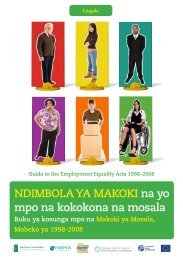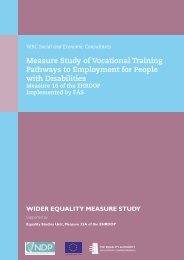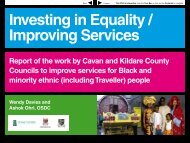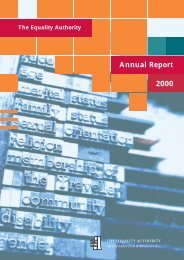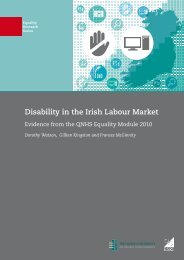Pregnancy and Employment: A Literature Review - Crisis Pregnancy ...
Pregnancy and Employment: A Literature Review - Crisis Pregnancy ...
Pregnancy and Employment: A Literature Review - Crisis Pregnancy ...
Create successful ePaper yourself
Turn your PDF publications into a flip-book with our unique Google optimized e-Paper software.
<strong>Pregnancy</strong> <strong>and</strong> <strong>Employment</strong>: A <strong>Literature</strong> <strong>Review</strong><br />
The analysis was limited to women who were employed during pregnancy <strong>and</strong> who were first <strong>and</strong> second-time<br />
mothers. The sampling strategy used means that the samples are not representative of the national populations.<br />
The analyses found that the higher the occupational position, the more likely women were to have returned to<br />
work in all three countries. This trend was strongest in Spain <strong>and</strong> weaker in Italy, which the authors suggest is<br />
related to the longer leave entitlements for Italian women (ibid, p184).<br />
The findings on the important effect of women’s human capital in the form of education <strong>and</strong> accumulated work<br />
experience on women’s re-entry to the work-force are confirmed by the chapters in the volume edited by Blossfeld<br />
<strong>and</strong> Drobnič (2001). The study contains analyses of women’s labour-market transitions in a wide range of countries<br />
(Germany, the Netherl<strong>and</strong>s, Belgium, Italy, Spain, Britain, US, Sweden, Denmark, Pol<strong>and</strong>, Hungary <strong>and</strong> China). These<br />
studies use national datasets containing retrospective life <strong>and</strong> work histories, but aim to construct the same type<br />
of models for each country, including a similar range of variables. This research differs from the studies outlined<br />
above in that the analyses are not restricted to women who have recently given birth, but look at women’s whole<br />
career <strong>and</strong> life-course.<br />
A similar approach is taken in Russell et al (2000) <strong>and</strong> Russell <strong>and</strong> O’Connell (2004). Both studies draw on six years<br />
of the Living In Irel<strong>and</strong> Panel Survey to examine women’s re-entry into employment across the life-course. The<br />
study included all women who had made a transition from home-duties to paid work between 1994 <strong>and</strong> 2001. A<br />
total of 30% of the returners had been out of the labour market for less than five years, <strong>and</strong> a similar proportion<br />
(31%) had children under five years old. The study also included older women who returned to employment from<br />
home duties after prolonged periods outside employment. For this broader section of the female population, the<br />
probability of resuming employment was significantly linked to educational qualifications, time out of the labour<br />
market <strong>and</strong> years of work experience.<br />
3.3 Demographic <strong>and</strong> Family Characteristics<br />
The second set of individual-level influences on return to work concerns women’s demographic/family<br />
characteristics. The figures outlined in Table 1.1 (Chapter 1) shows that the level of women’s participation in<br />
the labour market in Irel<strong>and</strong> <strong>and</strong> elsewhere is influenced by family characteristics such as the number <strong>and</strong><br />
age of children. The longitudinal studies discussed above have highlighted a range of other demographic <strong>and</strong><br />
family influences on the return decision, including: age of mother at birth, birth order, partnership status <strong>and</strong><br />
employment situation of the partner. While the literature suggests that the influence of the human-capital factors<br />
is fairly universal, the influence of demographic <strong>and</strong> family composition appears to be less consistent across<br />
countries. One possible explanation is that the effect of family characteristics on employment is more subject to<br />
the influence of social policy, which gives rise to greater variation between countries.<br />
Age of mother at birth<br />
The effect of the mother’s age on the likelihood of returning to work varies across countries. Among Irish women,<br />
Russell et al (2006) found that the likelihood of return decreased with age. Mothers aged over 35 were significantly<br />
less likely to have returned by the first interview after birth, compared to those aged under 30. A similar pattern<br />
was found in France; women aged 35 years or older were less likely to have resumed work, all other factors taken<br />
into account (Saurel-Cubizolles et al, 1999). However, in Spain, the oldest group of women were most likely to have<br />
resumed work, <strong>and</strong> age was not a significant factor in Italian women’s likelihood of returning (Saurel-Cubizolles et<br />
al, 1999). The authors suggest that the Spanish result may arise because the older mothers are more motivated to<br />
work as they joined the labour market in a period when women’s employment was not supported (ibid).<br />
Similarly, in their analysis of rates of return to the pre-birth employer, Waldfogel et al (1999) observe differing age<br />
effects in the three countries studied. In the UK <strong>and</strong> Japan, retention rates were higher among older women. In the<br />
US, by contrast, age had a negative effect on retention in the models; in other words, younger women were more<br />
likely to have returned.<br />
It is important to bear in mind that older age at first birth is related to other factors that influence return<br />
decisions. Longer educational careers <strong>and</strong> greater labour-force attachment are both likely to be associated with<br />
postponement of births. Educational attainment is also strongly linked to the number of children that women have<br />
PAGE 29




